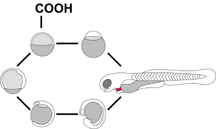Developmental Glycobiology Section
Kenneth Kramer, PhD, Principal Investigator
| |

|
 |
On the surface of virtually every cell are sugar-protein macromolecules
known as heparan sulfate proteoglycans, and embryos that lack
proteoglycans die early in development. The laboratory’s
main research objective is to understand how proteoglycans regulate
early zebrafish development. We use zebrafish as a model system
because several genetic tools enable us to readily manipulate
HSPGs during development, an approach that is critical to understanding
how proteoglycans function. The cardiovascular system is particularly
sensitive to our manipulations, and we are discovering multiple
roles for proteoglycans during cardiovascular development. We
are also developing new tools to decipher the spatial and temporal “heparan
code”, an array of tissue-specific heparan sulfate modifications
that have been proposed to mediate development. Because heparan
sulfate and many steps in zebrafish embryogenesis are similar
to those in humans, we expect the tools, mechanisms and modifiers
that we identify will be applicable to better understanding a
wide range of cell-cell signaling events in development and disease.
Main Projects:
|